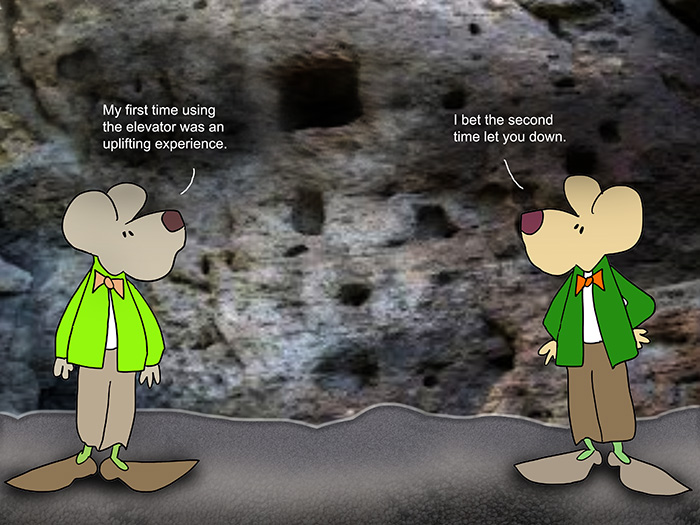I know I’ve written about Otis before. As in Elisha Otis. And the elevator. But when you think of how old the earth is and how long we’ve been climbing things like large rocks, ladders, and then stairs, it is pretty amazing that the elevator took so long to be invented. I mean, we humans and our ancestors have been walking the planet for about 6 million years. The homo sapiens — that’s us — the modern form of humans — evolved 300,000 years ago from Homo erectus. Up and down we went.
For a long time, we didn’t mingle with the others. It wasn’t until about 6,000 years ago that we started forming human civilizations. But we dwelt. Our families dwelt. For those 294,000 years, we lived somewhere, on our own. Grunting in the singular. Some of us started living high in places. Trees. High caves. We didn’t have to worry about tall dinosaurs getting us, as the dinosaurs died out nearly 65 million years before people appeared on Earth. Those old sci-fi movies were wrong. It is no wonder the dinosaurs at Jurassic Park were after us. We were tasty little hors d’oeuvres. Sidebar. Hors d’oeuvre need a better spelling. Who can ever remember this? It should be “orderves.”
Anyway, back to humans in high places. We started building things, like high-rise apartments and office buildings 100 floors up. We were spreading out, taking up too much space. We solved this by spreading up.
And that is where the elevator came in. It was on this date, March 23, 1857, when Elisha Otis installed his first elevator at 488 Broadway in New York City.
Since that first one, we’ve been going up in an enormous way. America currently has over 700,000 elevators. And, unlike motorcycles, elevators are statistically the safest way to travel. If given the choice in how you ascend, elevators are twenty times safer than escalators.
Some people have a great fear of getting stuck in an elevator. Or worse yet, being on one when it goes into a free-fall. But the elevator is worlds safer than riding in a car. On average, 26 people die each year in an elevator-related accident. They are mainly elevator technicians and not passengers. Conversely, 26 people die per hour in car-related accidents.
We’ll do anything to squelch our fears, even if it means the trade-off might be worse. Like elevator music. Those slippery tunes first appeared in the 1920s to calm those fearful passengers. I’m not sure when they stopped playing that music, but most elevators are now moving in peace and quiet. Thankfully.
Otis probably had no idea his invention would be so big. Every three days, elevators carry the equivalent of the Earth’s population. But not where I live. I’m not even sure if there are more than five elevators in the entire county. Maybe less.
While he devised the modern elevator, there were many more of these ideas before him. The first written record of an elevator comes from 3rd century BC Greece. That simple elevator was invented by mathematician Archimedes. They had elevators in Rome’s coliseum, pulled up and down by slaves.
Otis underestimated this invention. He neither applied for a patent nor asked his employer for compensation. As such, Otis died in 1861 and left behind debts of $8,200 and a $5,000 estate.
Yet, I think elevators are a lot like life. The obvious, as we try to reach our destination, we will experience all sorts of ups and downs. Yet. Doors open. Doors close. And as we visit each stop along the way, each place offers a wide variety of different options. We make the choice of which place we will go and explore. Stepping off. Stepping back on. All we need to do is push the right button, and away we go.
The way we go.
==========
“…there ain’t no journey what don’t change you some.”
― David Mitchell, Cloud Atlas
==========
“It is good to have an end to journey toward; but it is the journey that matters, in the end.”
― Ursula K. Le Guin
=========
“The only journey is the one within.”
― Rainer Maria Rilke
==========
Up. Down. In between. And away we go.
